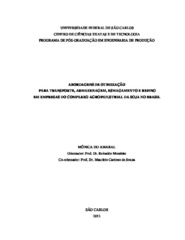Abordagens de otimização para transporte, armazenagem, esmagamento e refino em empresas do complexo agroindustrial da soja no Brasil
Abstract
Soybean is one of the most important Brazilian agricultural products and its complex - composed by grain, meal and by crude and refined oils - yields about $ 30 billion only in exports annually. Approximately 40% of soybeans harvested is exported, while the remaining 60% go through industries. After processing the soy grain, meal and crude oil are obtained, and crude oil can be further refined. These products can be domestically consumed or exported. This thesis propose optimization approaches based on network flow models to represent, at the operational level, decisions on intermodal transport, processing and storage along the chain. And, at the strategic level, we propose facility location models based on mixed integer programming to support investment decisions in intermodal terminals, in processing and refining facilities, besides in warehouses. To better represent this supply chain, which is a large scale system, it is also developed a highly sparse network structure, making the models more tractable computationally. In this study, the focus is on the decision-making process of companies in this sector, rather than aimming to support government decisions in the soybean chain, as in previous studies in the literature. Typical problems of companies are specialized only in the export of soybeans and also companies operating throughout the agribusiness chain of soybean and its byproducts. This assumption deals with a natural subdivision of the network flow models in problems oriented by single product, as in the case of the first companies, and by multiproducts in the case of other enterprises. Verification tests were conducted using secondary data and realistic scenarios to illustrate the applicability of the proposed approaches. For computational effort tests, instances were randomly generated. Tests conducted in an optimization software compares the computational performance of these models in different tests of control parameters, including the use of relaxations. Additionally, some mathematical programming based heuristics were proposed and tested - relax-and-fix and fix-and-optimize - for two location models of intermodal terminals, warehouses, refineries and overwhelming, comparing the results obtained with exact and approximate approaches.
Collections
The following license files are associated with this item:

